|
Tick, Tock, Time
by Bob Brooke
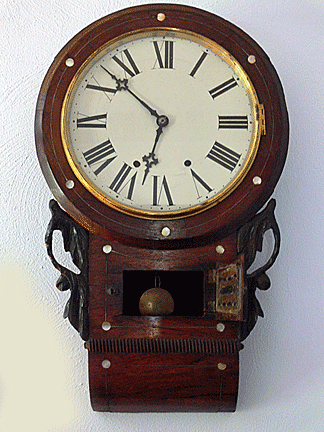 You
can tell a lot about a person by the number and kinds of clocks he or
she has in their home. Usually, it’s a person who’s always punctual, for
this is a person for whom time controls life. Then there’s the clock
collector, the person who obsesses over time and needs to have as many
different types of clocks, antique and otherwise, around. I’m one of
those persons. You
can tell a lot about a person by the number and kinds of clocks he or
she has in their home. Usually, it’s a person who’s always punctual, for
this is a person for whom time controls life. Then there’s the clock
collector, the person who obsesses over time and needs to have as many
different types of clocks, antique and otherwise, around. I’m one of
those persons.
I never thought about time controlling my life until I began to look at
all the clocks and watches I have around my house. I’m not obsessive
about time. In fact, lately, I tend to sleep in and maybe think about
time less than I used to. But I do love clocks and appreciate the
workmanship that goes into them.
I have a friend who collects clocks. He, too, appreciates the
workmanship in antique clocks. Unlike me, he searches out particular
clocks to add to his collection, sometimes trading ones he’s had for a
while for another type that a bit better. And that’s what a collector
does—constantly looks for ways to upgrade his or her collection.
It's All in the Name
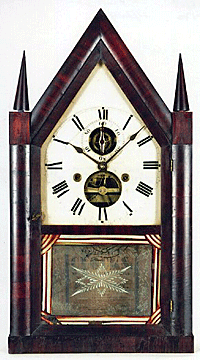 You
can tell a lot about a clock just by its name, before you even see it.
However, all clock names don’t always give clues to the kinds of clocks
they refer to. Some clock names give clues to the age, function and
appearance of the clock. Most collectors, for instance, know that an
automaton clock means it will have moving figures or objects as part of
the decoration. But what about a “skeleton” clock or a
“wag-on-the-wall.” Does the former look like a skeleton and does the
latter have a tail that wags? The answer is no on both counts. You
can tell a lot about a clock just by its name, before you even see it.
However, all clock names don’t always give clues to the kinds of clocks
they refer to. Some clock names give clues to the age, function and
appearance of the clock. Most collectors, for instance, know that an
automaton clock means it will have moving figures or objects as part of
the decoration. But what about a “skeleton” clock or a
“wag-on-the-wall.” Does the former look like a skeleton and does the
latter have a tail that wags? The answer is no on both counts.
By the late 1600s, the science of mechanical clock making continued to
develop in many European countries. In two towns, Nuremberg and
Augsburg, both in southern Germany, clock making had become somewhat of
an art. Once German clockmakers figured out the nuances of weight-driven
clocks, they became more common for home use. It was only then that
clockmakers could focus on giving their clock cases new shapes and
decoration. And it’s those shapes and decoration that led to the names
of some different types of clocks.
Among the earliest still surviving are the English lantern clocks and
table drum clocks. Popular at the time were the German miniature tower
or tabernacle clock and a variety of carriage clocks used by travelers.
By the 18th century, English clockmakers had begun to make their mark in
the clock world. Today, collectors look for the name of the maker of the
clock movements since clockmakers at that time didn’t often make their
cases but hired a cabinetmaker to make them. Most late 18th-century
French clocks, which had quality movements, are now known by the name of
the case-maker. In fact, after 1750, it’s the name of the ebenistes, or
cabinetmakers, that has been stamped on all wooden cases.
Some Unusual Clock Names
So let’s take a look at some of those odd-ball clock names.
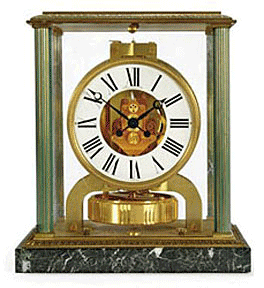 First
is the Atmos, short for atmospheric, a clock powered by the
changes in atmospheric pressure and temperature, invented by Cornelius
Drebbel in the early 17th century. But it wasn’t until 1928 that Jean-Léon
Reutter, an engineer in Neuchâtel, Switzerland, designed one for modern
use. Constant changes in atmospheric temperature kept the mainspring
fully wound. First
is the Atmos, short for atmospheric, a clock powered by the
changes in atmospheric pressure and temperature, invented by Cornelius
Drebbel in the early 17th century. But it wasn’t until 1928 that Jean-Léon
Reutter, an engineer in Neuchâtel, Switzerland, designed one for modern
use. Constant changes in atmospheric temperature kept the mainspring
fully wound.
Another popular clock is the Banjo, a wall clock with a
banjo-shaped case. First introduced in America by Simon Willard,
originally of Grafton, Massachusetts, later of Roxbury, Massachusetts,
as the "Improved Timepiece," and patented by him in 1802, it became so
popular that copies of older banjo clocks are constantly being made.
Only 4,000 authentic Simon Willard banjo clocks were ever made.
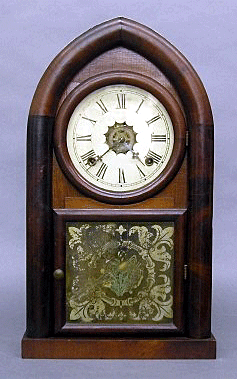 The
Beehive clock, made between 1850 and 1860 in Connecticut, is also
known as a "flatiron" because of its form and incorporated the American
symbol of the beehive for industry, health and hard work. The
Beehive clock, made between 1850 and 1860 in Connecticut, is also
known as a "flatiron" because of its form and incorporated the American
symbol of the beehive for industry, health and hard work.
Everyone loves cuckoo clocks, also known as Black Forest clocks.
Clockmakers in the 19th century from the Black Forest area of Germany
and northern Switzerland made these intricate works of folk art. The
cases are usually made of dark, heavily carved wood and feature a cuckoo
bird who promptly appears on the hour and half hour, as well as weights
resembling pine cones.
One of the first novelty clocks was the Blinking Eye clock. Eyes
connected to the escapement or a human or animal figure, move with each
unlocking of the lever. Originally made in Germany in the 17th century,
it wasn’t until the mid-19th century that they made their appearance in
the United States.
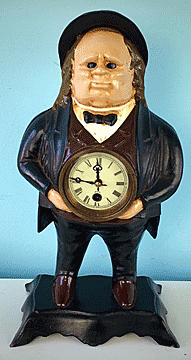 The
Rococo cases of the Cartel clock, originally popular in 18th
century France, then England, were usually carved wood, when English,
and cast brass or gilt bronze when French. The
Rococo cases of the Cartel clock, originally popular in 18th
century France, then England, were usually carved wood, when English,
and cast brass or gilt bronze when French.
Gothic or Steeple clocks emerged in the 1500s and 1600s in the
form of a Gothic church, with a sharp pointed top and usually two
“steeples.” They didn’t appear in America until Elias Ingraham produced
one in Connecticut in 1845.
Always seeking creative clock designs, clockmakers came up with what’s
known as a Mystery clock, so named because its works are hidden,
making it seem as if it works mysteriously. The hands on these clocks
appear to be suspended without any means of driving them.
During the 19th century, the Pillar and Scroll clock, a shelf
clock with pillars and a double scroll or broken arch on the top, was
popular.
 One
of the most unusual clock names is Wag-on-the-Wall. While this
refers to any clock with weights and a pendulum not enclosed in a case,
it most refers to caseless French Morbier clocks which feature an extra
large embossed brass pendulum that resembles a horse’s tail. One
of the most unusual clock names is Wag-on-the-Wall. While this
refers to any clock with weights and a pendulum not enclosed in a case,
it most refers to caseless French Morbier clocks which feature an extra
large embossed brass pendulum that resembles a horse’s tail.
Late 18th-century clockmakers created the Wall Regulator clock,
in a quest for greater timekeeping accuracy. They were weight-driven
devices and featured a deadbeat escapement. To ensure their accuracy,
they usually omitted complicated features like calendars. Instead, each
of the clock’s hands worked off a different mechanism. The English
didn’t especially take to Regulator clocks, but the Viennese did. In
fact, Vienna regulator wall clocks gained such a reputation for accuracy
that they were routinely used in public places such as railway stations
and post offices.
<
Back to Antiques Extra! Archives
Next Editorial >
|
